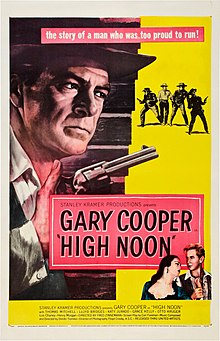Redemptive violence
Redemptive violence is defined as a belief that "violence is a useful mechanism for control and order",[1] or, alternately, a belief in "using violence to rid and save the world from evil".[2] The French Revolution involved violence that was depicted as redemptive by revolutionaries,[3][4] and decolonization theorist Frantz Fanon was an advocate of redemptive violence.[5] Pacifism rejects the idea that violence can be redemptive.[6][7]
Myth
The myth of redemptive violence is the story of the victory of order over chaos by means of violence. It is the ideology of conquest, the gods favour those who conquer.[8]
Today’s common understanding of the Myth of Redemptive Violence was put forward by American scholar and theologian Walter Wink in his book, The Powers that Be: Theology for a New Millenium,[9] wherein he defines the Myth of Redemptive Violence as “the belief that violence saves, that war brings peace, that might makes right.”[9]
Domination system
Redemptive violence is the means by which

In early history
The myth of redemptive violence can be traced all the way back into biblical times. For instance, the Babylonian creation story from 1250 BCE follows the same blueprint as virtually every story of redemptive violence put forward today. In this story, known as the Enuma Elish, the god Marduk, defeats the god Tiamat in a fierce battle, and then creates the world using her body. He then uses the blood of another slain god, Qingu to create humans.[10]
Depictions of redemptive violence can also be seen in various art forms throughout early human history.[11]
In modern culture
In describing the Myth of Redemptive Violence, Walter Wink points to the popular 1950s cartoon, Popeye and Bluto, describing the basic plot that is repeated in nearly every episode.[9]
“In a typical segment, Bluto abducts a screaming and kicking Olive Oyl, Popeye’s girlfriend. When Popeye attempts to rescue her, the massive Bluto beats his diminutive opponent to a pulp, while Olive Oyl helplessly wrings her hands. At the last moment, as our hero oozes to the floor, and Bluto is trying, in effect, to rape Olive Oyl, a can of spinach pops from Popeye’s pocket and spills into his mouth. Transformed by this gracious infusion of power, he easily demolishes the villain and rescues his beloved. The format never varies. Neither party ever gains any insight or learns from these encounters. They never sit down and discuss their differences. Repeated defeats do not teach Bluto to honour Olive Oyl’s humanity, and repeated pummellings do not teach Popeye to swallow his spinach before the fight.”
— Walter Wink, The Powers that Be: Theology for a New Millenium

Wink points out that no matter what happens, Popeye continues to use violence as the only means of solving problems because he never learns that there is another option. He sees violence as a necessity; as the only possible way to solve a problem, and never learns that any other method would solve the problem.
References
- S2CID 144993999.
- S2CID 25517213.
- .
- S2CID 149297263.
- ISBN 978-0-230-11999-4.
- .
- .
- ^ Wink, Walter (2023-02-21). "The Myth Of Redemptive violence" (PDF). The Myth Of redemptive violence by Walter wink. Retrieved 2023-02-21.
- ^ ISBN 9780385487528.
- ^ Mark, Joshua J. "Enuma Elish - The Babylonian Epic of Creation - Full Text". World History Encyclopedia. Retrieved 2023-10-29.
- ^ "Violence in art", Wikipedia, 2023-08-15, retrieved 2023-10-29
Further reading
- Beaumont, Thomas E. (2020). "The Phenomenology of Redemptive Violence". Alternatives: Global, Local, Political. 45 (4): 184–199. S2CID 232233904.
- Bielefeld, Shelley (2021). "Cashless welfare transfers and Australia's First Nations: redemptive or repressive violence?". Griffith Law Review. 30 (4): 597–620. S2CID 242072134.
- Cothran, Boyd (2014). Remembering the Modoc War: Redemptive Violence and the Making of American Innocence. UNC Press Books. ISBN 978-1-4696-1861-6.
- Dalton, Jacob P. (2012). "Sometimes Love Don't Feel Like It Should: Redemptive Violence in Tantric Buddhism". Sins and Sinners: Perspectives from Asian Religions. Brill. ISBN 978-90-04-23200-6.
- Dalton, Russell W. (2015). "(Un)Making Violence Through Media Literacy and Theological Reflection: Manichaeism, Redemptive Violence, and Hollywood Films". Religious Education. 110 (4): 395–408. S2CID 141818053.
- Duong, Kevin (2020). The Virtues of Violence: Democracy Against Disintegration in Modern France. Oxford University Press. ISBN 978-0-19-005841-8.
- Forbes, Ella (1998). ""By My Own Right Arm": Redemptive Violence and the 1851 Christiana, Pennsylvania Resistance". The Journal of Negro History. 83 (3): 159–167. S2CID 141075568.
- Harison, Casey (2011). "Redemptive violence and stuttering across the Atlantic: The Who's "My Generation" and Herman Melville's Billy Budd in historical perspective". Atlantic Studies. 8 (1): 49–68. S2CID 161895257.
- Lavender, Wayne (2015). The Worldview of Redemptive Violence in the US. Springer. ISBN 978-1-137-47911-2.
- McDowell, John C. (2010). ""Wars Not Make One Great": Redeeming the Star Wars Mythos from Redemptive Violence Without Amusing Ourselves to Death". The Journal of Religion and Popular Culture. 22 (1): 4. .
- Morris, Barry (1992). "Frontier colonialism as a culture of terror". Journal of Australian Studies. 16 (35): 72–87. .
- Stevens, Ellie Emslie (2017). "Eschatological Inversions in Isaiah and Dante: From Malicious to Redemptive Violence". Annali d'Italianistica. 35: 51–70. JSTOR 26570505.
- Ingleby, Johnathan. “Confronting the Domination System - JSTOR.” JSTOR, Sage Publications Ltd., www.jstor.org/stable/43052707. Accessed 29 Oct. 2023.
